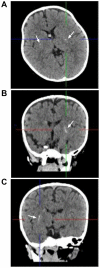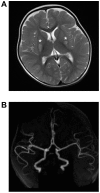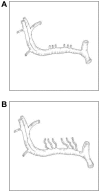Current status of infarction in the basal ganglia-internal capsule due to mild head injury in children using PRISMA guidelines
- PMID: 32010282
- PMCID: PMC6966180
- DOI: 10.3892/etm.2019.8320
Current status of infarction in the basal ganglia-internal capsule due to mild head injury in children using PRISMA guidelines
Abstract
Post-traumatic basal ganglia-internal capsule (BGIC) infarction in pediatric patients is a relatively rare consequence of mild head injury (MHI). To the best of the authors' knowledge, at present, no comprehensive review has been published. To review research on BGIC infarction after MHI, a literature search was performed using the PubMed database and relevant search terms. According to recent data, MHI may cause BGIC infarction due to mechanical vasospasm of the perforating vessels in pediatric patients. The anatomical characteristics of the growing brain in infancy, mineralization of the lenticulostriate arteries and viral infection may all play a part in BGIC infarction after MHI, which often occurs within 24 months. Symptoms are not as severe and tend to disappear in the early period. Computed tomography or magnetic resonance imaging often shows BGIC infarction. There are also children with scattered calcification of the basal ganglia. Neural rehabilitation is a commonly accepted treatment. The prognosis of patients with BGIC infarction after MHI consistently improves.
Keywords: basal ganglia-internal capsule; children; infarction; mild head injury.
Copyright: © Wang et al.
Figures




Similar articles
-
A Case of Lenticulostriate Stroke Due to Minor Closed Head Injury in a 2-Year-Old Child: Role of Mineralizing Angiopathy.Pediatr Emerg Care. 2018 Dec;34(12):e233-e235. doi: 10.1097/PEC.0000000000001229. Pediatr Emerg Care. 2018. PMID: 28816772
-
Vessel Wall Magnetic Resonance Imaging in a Case of Post-traumatic Multifocal Striatocapsular Hemorrhagic Infarction.Neurol Med Chir (Tokyo). 2019 May 15;59(5):191-195. doi: 10.2176/nmc.cr.2018-0316. Epub 2019 Apr 17. Neurol Med Chir (Tokyo). 2019. PMID: 30996152 Free PMC article.
-
Stroke After Minor Head Trauma in Infants and Young Children With Basal Ganglia Calcification: A Lenticulostriate Vasculopathy?J Child Neurol. 2018 Feb;33(2):146-152. doi: 10.1177/0883073817750501. J Child Neurol. 2018. PMID: 29334856
-
Recovery from mild head injury in pediatric populations.Semin Pediatr Neurol. 2003 Jun;10(2):130-9. doi: 10.1016/s1071-9091(03)00021-4. Semin Pediatr Neurol. 2003. PMID: 14572149 Review.
-
Mild head injury: neuropathology, sequelae, measurement and recovery.Br J Clin Psychol. 1997 May;36(2):161-84. doi: 10.1111/j.2044-8260.1997.tb01405.x. Br J Clin Psychol. 1997. PMID: 9167859 Review.
Cited by
-
Basal ganglia infarct secondary to moya moya disease in a child with traumatic head injury: a case report and review of literature.BMC Neurol. 2025 Jul 30;25(1):310. doi: 10.1186/s12883-025-04340-z. BMC Neurol. 2025. PMID: 40739206 Free PMC article. Review.
-
White Matter Fiber Tracking Method with Adaptive Correction of Tracking Direction.Int J Biomed Imaging. 2024 Feb 5;2024:4102461. doi: 10.1155/2024/4102461. eCollection 2024. Int J Biomed Imaging. 2024. PMID: 38348198 Free PMC article.
-
[Clinical characteristics and long-term follow-up study of basal ganglia infarction after minor head trauma in infants and young children].Zhongguo Dang Dai Er Ke Za Zhi. 2025 Jan 15;27(1):68-74. doi: 10.7499/j.issn.1008-8830.2408136. Zhongguo Dang Dai Er Ke Za Zhi. 2025. PMID: 39825654 Free PMC article. Chinese.
References
Publication types
LinkOut - more resources
Full Text Sources
